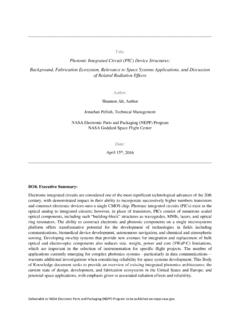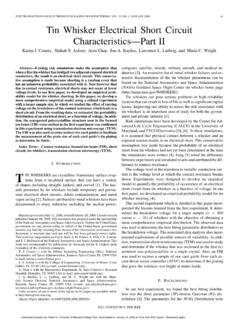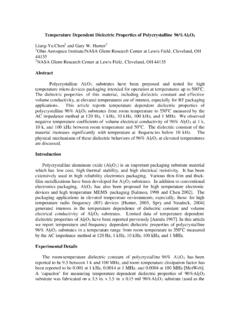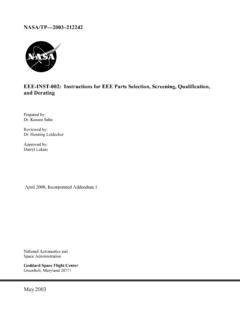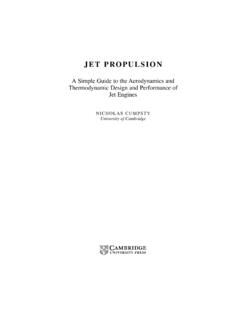Transcription of Assessing and Mitigating Radiation Effects in Xilinx FPGAs
1 National Aeronautics and Space Administration Assessing and Mitigating Radiation Effects in Xilinx FPGAs Philippe Adell jet propulsion Laboratory California Institute of Technology Pasadena, California Greg Allen jet propulsion Laboratory California Institute of Technology Pasadena, California jet propulsion Laboratory California Institute of Technology Pasadena, California JPL Publication 08-9 2/08 National Aeronautics and Space Administration Assessing and Mitigating Radiation Effects in Xilinx FPGAs NASA Electronic Parts and Packaging (NEPP) Program Office of Safety and Mission Assurance Philippe Adell jet propulsion Laboratory California Institute of Technology Pasadena, California Greg Allen jet propulsion Laboratory California Institute of Technology Pasadena, California NASA WBS: JPL Project Number: 102197 Task Number: jet propulsion Laboratory 4800 Oak Grove Drive Pasadena, CA 91109 ii This research was carried out at the jet propulsion Laboratory, California Institute of Technology, and was sponsored by the National Aeronautics and Space Administration Electronic Parts and Packaging (NEPP) Program.
2 Reference herein to any specific commercial product, process, or service by trade name, trademark, manufacturer, or otherwise, does not constitute or imply its endorsement by the United States Government or the jet propulsion Laboratory, California Institute of Technology. Copyright 2008. California Institute of Technology. Government sponsorship acknowledged. iii TABLE OF CONTENTS 1 INTRODUCTION 1 2 Xilinx FPGAs AND Radiation Effects 4 INTRODUCTION 4 Xilinx SRAM FPGAs 5 PRODUCT DESCRIPTION 5 PRODUCT EVOLUTION 6 Xilinx Radiation ISSUES 6 3 Radiation Effects : TESTING METHODOLOGIES AND RESULTS 8 GENERAL RECOMMENDATION FOR TESTING Xilinx FPGAs WITH HEAVY IONS 8 STATIC CHARACTERIZATION OF Xilinx FPGAs 9 CONFIGURATION LOGIC BLOCKS AND BLOCK RAM 10 USER FLIP-FLOPS 10 HALF-LATCHES 11 SINGLE-EVENT FUNCTIONAL INTERRUPT (SEFI)
3 TESTING 11 SINGLE-EVENT LATCH-UP TESTING 12 STATIC DATA ANALYSIS AND SIGNIFICANT RESULTS 12 CONFIGURATION-BIT CROSS SECTION 12 BLOCK RAM 13 DYNAMIC AND MITIGATED METHODOLOGIES 14 MULTIPLE-BIT UPSET: MBU 14 4 Xilinx SRAM FPGAs MITIGATION TECHNIQUES 17 INTRODUCTION 17 MITIGATION BASICS 18 TRIPLE MODULAR REDUNDANCY (TMR) 18 CONFIGURATION SCRUBBING 20 TMRTOOL 21 MITIGATION.
4 TECHNICAL ASPECTS 21 INPUT/OUTPUT 22 Signal Integrity Inputs 22 Signal Integrity Outputs 22 TMRTOOL ASYNC DATA TRANSFER 23 TMRTool ASYNC FIFO 24 Unaligned Clocks (Phase Shift between Clocks) 24 ADDITIONAL ISSUES RELATED TO TIMING CONSTRAINTS 26 XTMR Static Timing Constraints (1) 26 TMRTool Beat Time 27 TMRTool Simulation 28 5 CONCLUSION 29 6 REFERENCES 30 1 1 INTRODUCTION There are two main categories of Radiation Effects that are relevant for Static Random Access Memory (SRAM) Field-Programmable Gate Arrays ( FPGAs ) in space: Total-Dose Effects and Single-Event Effects (SEEs).
5 Total-Dose Effects are cumulative Effects that induce degradation of electrical parameters at the device, circuit, and system levels. They are induced by the total amount of ionizing energy deposited by photons or particles such as electrons, protons, or heavy ions. SEEs are induced by the passage of a single high energy proton or heavy ion through a device or a sensitive region of a microcircuit. SEEs in digital integrated circuits (ICs) can be either destructive ( , Single-Event Latch-up [SEL]), or non-destructive, such as the occurrence of transient faults in combinational and sequential logic. A good review of these Effects (SEL, Single-Event Functional Interrupt [SEFI], Single-Event Transients [SET], Single-Event Upset [SEU], and Multiple-Bit Upset [MBUs]) with respect to different FPGA architectures can be found in [1]. This document provides an understanding of SEEs in FPGA components with a specific interest on Xilinx SRAM FPGAs .
6 It also provides help to designers to identify appropriate testing and mitigation strategies to qualify these parts for space application. FPGAs have been very attractive for space applications over the past decade. Indeed, the main advantage provided by gate arrays is the elimination of the large overhead cost (~ $250k) of developing custom application-specific integrated circuits (ASICs). Another advantage, provided by SRAM-configured gate arrays is the ability to reprogram existing devices, addressing evolving needs during hardware development or special requirements that are needed before and during a space mission. Currently, the two main technologies that are used for FPGA devices are antifuse-based and SRAM-based. Many NASA systems have used gate arrays that employ antifuse technology, where permanent connections are programmed by high-current pulses that change the state of small regions in the gate array, making circuit connections.
7 There are two primary antifuse technologies: oxide-nitride-oxide (ONO) and metal-to-metal (M2M). The ONO-based antifuse consists of a dielectric sandwich of silicon dioxide grown over the n-type antifuse diffusion, a silicon nitride layer, and another silicon dioxide layer. The ONO layer lies between a polysilicon conductor and a heavily doped n+ diffusion region of the base of the silicon wafer. When a programming voltage is applied, the ONO sandwich melts and a bump is formed into the polysilicon layer. The bump shatters the ONO layer, allowing diffusion of the substrate n+ into the polysilicon to form a low resistance path. The second antifuse switch, M2M, is constructed between two metal layers. The antifuse material is composed of layers of dielectrics and amorphous silicon. M2M antifuses hold an advantage over ONO as their programmed resistance is much lower, allowing for improved design performance.
8 Antifuse technology has several inherent limitations that make SRAM-based FPGAs more attractive. First, once a device is programmed, it cannot be changed; additional devices have to be programmed and physically replace the installed devices. Second, available antifuse gate arrays are considerably smaller in gate count than SRAM-configurable gate arrays. As in most competing technologies, there are engineering tradeoffs that designers must take into account. The one-time programmability that in some cases is seen as a 2 limitation gives way to SEU robustness. While offering the attractive feature of re-configurability, SRAM-configured gate arrays also have some limitations as well. They are not one-chip replacements for ASICs as they require off-chip configuration storage, typically an Electrically Erasable Read-Only Memory (EEPROM).
9 Space-qualified versions of these devices are relatively expensive (~ $10k each). The SRAM in presently available devices is quite soft to upsets in the space Radiation environment so that the functionality of a design can be broken due to an upset in the configuration. The potential for configuration upset in SRAM-based FPGAs may only be an inconvenience for some instrument-type applications like cameras, but has precluded NASA from previously recommending them for critical applications, particularly where spacecraft control was involved. The development and verification of configuration error mitigation now means that it is possible to use these devices in critical applications. Indeed, recent successes are indicative of the feasibility of SRAM-based FPGA technology insertion for NASA missions. For example, Mars Exploration Rover s Spirit and Opportunity landers had SRAM-based FPGAs that sequenced entry-descent-and-landing pyro firings and currently controlling motors on the rovers in conjunction with one time programmable (OTP) FPGAs .
10 A representation of the number of upsets after the number of days after launch is given in Figure 1. Figure 1. Pyro Control (LPSIF) Xilinx XQR4062XL. The main purpose of this guideline is to document the current understanding of the effort and tradeoffs involved in using SRAM-based FPGAs with maximum achievable upset tolerance. This guideline summarizes the different testing strategies to be considered when Assessing the SEE tolerance of SRAM-based FPGAs . For critical applications, in-beam testing of flight designs is strongly recommended in order to verify that the upset mitigation is working as well as the designer intended. At present, there are 3 four manufacturers (Actel, Xilinx , Atmel, and Aeroflex) offering six FPGA types to the military market ( , some military spec screening and testing are specified) and four device types to the aerospace application market, which indicates that the manufacturers have added Radiation parameter specifications.

